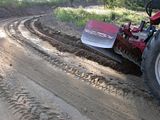canoetrpr
Veteran Member
- Joined
- Aug 7, 2005
- Messages
- 2,382
- Location
- Ontario, Canada
- Tractor
- Kubota M7040 cab/hyd shuttle - current, Kubota L3400 - traded
I tried a few different things today.
If I lenghten the top link to the maximum my front blade will definately dig in and fill the box as I drag. I can imagine that if the top link was even longer I might reach an angle where the front blade does not cut any more. Not sure if this is what johnk is able to do.
OTOH, if I follow the manuals recommendation of shortening the top link so that the front blade is just off the ground, it DOES leave a smoothed surface. One problem I see with this is that the side plates do dig in the ground and I can leave a gouge on both sides. Operating like this is a tad odd. When I start moving, the box fills about half way and then stays at that level. Seems like new material is added to the box and old material leaves out the back with the hinged rear blade putting weight on it and smoothing it out. I'll have to have my wife video this so I can see exactly what is happenning.
It seems incorrect to have the side plates gouging the surface. I think I'll drop a note to Woods to see what they are talking about in the manual.
In the meanwhile, if someone else has a hinged box blade, please let me know how you manage to do the finish grade / smoothing. I know that FarmWithJunk has the same blade I do but longer. I might PM him and point him to this thread.
If I lenghten the top link to the maximum my front blade will definately dig in and fill the box as I drag. I can imagine that if the top link was even longer I might reach an angle where the front blade does not cut any more. Not sure if this is what johnk is able to do.
OTOH, if I follow the manuals recommendation of shortening the top link so that the front blade is just off the ground, it DOES leave a smoothed surface. One problem I see with this is that the side plates do dig in the ground and I can leave a gouge on both sides. Operating like this is a tad odd. When I start moving, the box fills about half way and then stays at that level. Seems like new material is added to the box and old material leaves out the back with the hinged rear blade putting weight on it and smoothing it out. I'll have to have my wife video this so I can see exactly what is happenning.
It seems incorrect to have the side plates gouging the surface. I think I'll drop a note to Woods to see what they are talking about in the manual.
In the meanwhile, if someone else has a hinged box blade, please let me know how you manage to do the finish grade / smoothing. I know that FarmWithJunk has the same blade I do but longer. I might PM him and point him to this thread.


